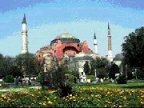What is now called Asian Istanbul was probably inhabited by people as early as 3000 BC. Eventually, in the 7th century, Greek colonists led by King Byzas established the colony of Byzantium, the Greek name for a city on the Bosphorus. Byzas chose the spot after consulting an oracle of Delphi who told him to settle across from the "land of the blind ones." Indeed, Byzas concluded, earlier settlers must have been deprived of their sight to have overlooked this superb location at the mouth of the Bosphorus strait. This proved an auspicious decision by Byzas, as history has shown Istanbul's location important far beyond what these early Greek settlers might possibly have conceived. Byzas gave his name to the city: Byzantium.
In the early 100's BC, it became part of the Roman Empire and in 306 AD, Emperor Constantine the Great made Byzantium capital of the Eastern Roman Empire. From that point on, the city was known as Constantinople.
 The mid 400's AD was a time of enormous upheaval in the empire. Barbarians conquered the western Roman Empire while the Eastern, also called the Byzantine Empire, kept Constantinople as its capital. In 532 during the reign of Justinian I, antigovernment riots destroyed the city. It was rebuilt, and outstanding structures such as Hagia Sophia stand as monuments to the heights Byzantine culture reached.
The mid 400's AD was a time of enormous upheaval in the empire. Barbarians conquered the western Roman Empire while the Eastern, also called the Byzantine Empire, kept Constantinople as its capital. In 532 during the reign of Justinian I, antigovernment riots destroyed the city. It was rebuilt, and outstanding structures such as Hagia Sophia stand as monuments to the heights Byzantine culture reached.
The attribute that made the city so desirable, its incomparable location for trade and transport between three continents, was also its nemesis. For the next several hundred years Persians, Arabs, nomadic peoples, and members of the Fourth Crusade (who for a time governed the city) attacked Constantinople.
In 1453, when Constantinople was so weakened by almost constant invasions and battles, the Ottoman Turks led by Sultan Mehmet II were able to conquer the city. Renamed Istanbul, it became the third and last capital of the Ottoman Empire. It was the nerve center for military campaigns that were to enlarge the Ottoman Empire dramatically. By the mid 1500's, Istanbul, with a population of almost half a million, was a major cultural, political, and commercial center. Ottoman rule continued until it was defeated in the First World War resulting Istanbul to be occupied by the allies.
When the Republic of Turkey was born in 1923 after the War of Independence, Kemal Ataturk moved the capital to the city of Ankara. The city of Istanbul has continued to expand dramatically and today its population is almost 16 million and increases at an estimated 700,000 person per year. Industry has expanded even as tourism has grown. It continues to be a city that creates its own history at the meeting point of the two continents; Europe and Asia.
Some of the interesting districts of the city are: Sultanahmet, Haydarpasa, Üsküdar, Eyüp, Galata, Pera, Ortaköy, Taksim, Eminönü, Fatih, Balat, and the Bosphorus. Princess Islands are a popular summer resort for local people.

